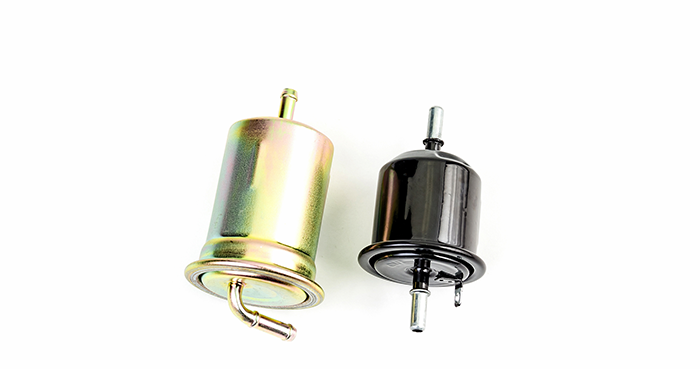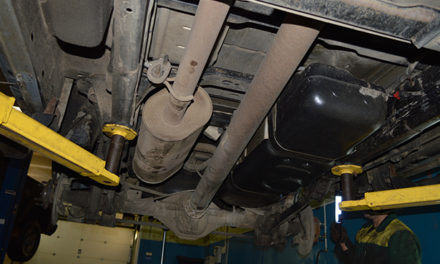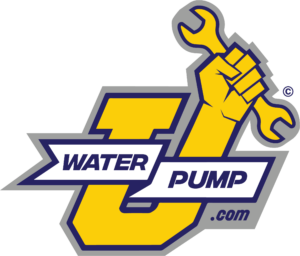A clean fuel filter is crucial to keeping a fuel delivery system in proper working order. By filtering out impurities from fuel, the filter prevents fuel injectors from becoming clogged and helps maintain a vehicle’s peak performance level.
Why Is The Fuel Filter Important? Isn’t Gasoline Already Refined?
Yes, fuel is cleaned in the refinery, but it picks up a lot of impurities during storage and transportation to your local gas station. Plus, a car’s gas tank typically contains dirt and other particles that can wreak havoc on an engine.
A clogged fuel filter forces the fuel pump to work harder and less efficiently. When you accelerate, a starved engine uses a leaner fuel mixture and loses power. Replacing the fuel filter regularly prevents those particles and impurities from reaching the fuel injectors. Check your owner’s manual for the manufacturer’s recommended filter replacement intervals.
Where Do I Find The Fuel Filter?
Some modern vehicles use an external fuel filter that is attached to the fuel supply line. This is connected to the gas tank and the fuel rail that feeds the fuel injectors. You can find the fuel filter simply by following the supply line.
Several applications now feature the fuel filter as part of the fuel pump module assembly, which is located inside the tank. For these vehicles, a faulty or clogged fuel filter generally indicates problems with the fuel pump as well. For some of these, you can just replace the fuel filter by itself but for most, you have to replace the complete fuel pump module assembly.
How Do I Replace An External Fuel Filter?
In this example, we’re replacing the fuel filter on a 1999 Ford Expedition. The same procedure applies to most Ford cars, SUVs, and trucks. To remove the filter you will need a few tools. You will need some wrenches, a fuel line disconnect tool, a screwdriver, and a drain pan.
- Disconnect the negative battery cable for extra safety.
- Relieve the fuel pressure with one of these methods:
- Press the pressure relief valve that’s located on the fuel rail.
- Take out the fuel pump fuse, then start the engine. Let it run until it dies from using all the fuel remaining in the line. Turn off the ignition.
- Place the drain pan under the filter to catch any fuel that may spill. Take off the safety clips from the fuel filter and fuel lines.
- Slip a fuel line disconnect tool all the way in between the tip of the fuel filter and the fuel line. The tool pushes out the tabs that hold the fuel line in place, allowing you to detach it from the filter.
- With one hand, hold the tool against the fuel line. Use your other hand to pull the line out. Disconnect both lines, then remove the fuel filter.
- Loosen the worm gear clamp that secures the fuel filter to the frame. Slide the filter forward out of the clamp.
- Apply petroleum jelly as a lubricant either on the ends of the new filter or on the O-ring seals in the fuel lines. Slide the new filter into the clamp and tighten the clamp. Reconnect the fuel lines by pushing them onto the new filter until they lock in place.
- Replace the negative battery cable.
- Start the engine and make sure no fuel leaks are present.






![[Vehicle Fitment]: Compatible with Chevrolet Cruze 2011-2015, Cruze Limited 2016, Sonic 2012-2015---L4 1.8L [Reference Number]: The A-Premium Fuel Injector's reference number: FJ1153, 800-2189N, 8002189N, 55570284, 25185231. Before placing an order, ...](https://m.media-amazon.com/images/I/41DuewWh9KL._SL100_.jpg)
![[Vehicle Fitment]: Compatible with Lexus ES300h 2013-2018 L4 2.5L, NX300h 2015-2019 L4 2.5L; Compatible with Scion tC 2011-2016 L4 2.5L; Compatible with Toyota Avalon 2013-2018 L4 2.5L, Camry 2010-2017 L4 2.5L, Highlander 2009-2019 L4 2.7L, RAV4 2017...](https://m.media-amazon.com/images/I/41RNa8GR0FL._SL100_.jpg)
![[Vehicle Fitment-1]: Compatible with Land Rover LR3 2005-2009, Range Rover 2006-2009, Compatible with Range Rover Sport 2006-2009---V8 4.4L [Vehicle Fitment-2]: Compatible with Jaguar S-Type 2003-2005, Vanden Plas 2004-2005, XJ8 2004-2005, XK8 2003-2...](https://m.media-amazon.com/images/I/51oWveOip3L._SL100_.jpg)



Thank you for informing me that a fuel filter sits on the fuel supply line, and if it is clogged, then it can make your engine work a lot harder. About a month ago, I bought an old used dirtbike. I want to clean it and get it all operational again. I am going to need a lot of supplies to repair components. It sounds like I will have to look at fuel filters that I can replace to make sure the engine will run efficiently.
Why you should replace your fuel filter
Like any filter, debris will clog it up over time. This causes the fuel pump to work harder, which can in turn lead to it breaking down. Engines can also be damaged from contaminated fuel. … “If debris enters the fuel injector, it can clog the fuel passages and damage the injector.
Thank you for very good advice, I wanted to try changing mine on a Honda Accord 95, I sweated like crazy but finally, you gave me hope to do it.
Such A Great Blog. Thank U For Sharing Useful Information Abou how-to-remove-push-lock-fuel-line-without-tool .
This Article Really Amazing And So Much Helpful For Me. Keep It Up. Thanks.
I like that you mentioned how a clean fuel filter is crucial to keeping a fuel delivery system in proper working order. I was reading one of my younger brother’s books yesterday and I learned about fuel filtration systems. I didn’t know that such a part actually exists, but it definitely seems essential.